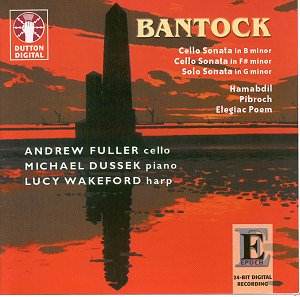GRANVILLE BANTOCK (1868-1946)
Cello Sonata in B minor (1940) [27.00]
Cello Sonata in F sharp minor (1944) [18.16]
Sonata in G minor for solo cello (1924)
[10.38]
Hamabdil and Pibroch for cello and harp [5.35,
6.36]
Elegiac Poem (1900)
[6.06]
 Andrew Fuller (cello)
Andrew Fuller (cello)
Michael Dussek (piano)
Luct Wakeford (harp)
rec All Saints, East Finchley 17-19 July 2000
Birmingham Conservatoire Research Project
funding
 DUTTON EPOCH CDLX
7107
[75.27]
DUTTON EPOCH CDLX
7107
[75.27]
Amazon UK £8.99

Bantock's natural mise-en-scène is the orchestra and the voice. Chamber
music seems a less obvious, more meagre, channel for this Big Man. However
GB did in fact produce a large number of chamber works. The Third Violin
Sonata has already been recorded (Universal - Susanne Stanzeleit) and a
collection based on a BBC Radio 3 broadcast from a Sunday afternoon
in 1994 has been rumoured for an ASV disc for the last five or so years.
This Dutton is the first all-Bantock chamber collection and the cello, the
baritone singer of the orchestra, is at the centre of the release.
The 1940 sonata has its origins in a work of 1900. The voice of the cello
is almost constantly in song. That singing quality is Dvorakian. The second
movement is handled with delicacy by both artists while the allegretto
is spirited and innocent in the mode of Macdowell. The Bachian aplomb
of the finale is updated with Beethovenian spirit.
Hamabdil (taken from the composer's incidental music for Arnold Bennett's
Judith to which Goossens also contributed) is music of rhapsodic flourish,
made yet more eloquent by the harp part. The Sapphic swirls of the harp at
2.33 recall the Hyperion recording of the Sappho Fragments. The music
has a Mohammedan melismatic sway typified by Adolphe Biarent. The pellucid
Highland Lament of Pibroch is dated 14 June 1917. It has the dewy
horizon-fixed stare of the type also caught by John Foulds' Celtic
Lament. Both works were played (with orchestra) at the Bantock memorial
concert in 1946.
The 1945 Cello Sonata is largely of a piece with the 1940 Sonata but Bachian
excursions, like the statement at 2.40, are more common. Dvorak's singing
lines flow along with a dash of Saint-Saëns too. Grace and smiles hang
over the lentamente.
These two Sonatas are not big bold works like the Foulds or Bowen or even
the Ernest Walker - all available on a single glorious British Music Society
CD.
The unaccompanied sonata is a Bachian effusion with gravity offset by the
Mephistophelean moto furioso of the allegro. The breath is well and
truly taken by this work. Wow! Give it a try. That said this is not a work
with the emotional reach of the Kodaly sonata nor, for that matter, of Bax's
Rhapsodic Ballad.
The Elegiac Poem is out of the same 'house style' as the short cello
works by Frank Bridge and Glazunov. Unassuming, polished, romantic, nodding
to Chopin at one moment, then to Dvorák, then to Rachmaninov.
High praise is merited by all players and to the engineering and production
team for conjuring the most natural of sounds.
God bless Dutton for this, their second, Bantock disc. Now how about the
complete three violin sonatas and the viola sonata? These are works with
still greater emotional drive.
I hope that Andrew Fuller will now be offered an anthology disc of the Bantock
works for cello and orchestra including Sapphic Poem superbly done
on Hyperion by Julian Lloyd Webber, Hamabdil, Elegiac Poem,
perhaps coupled with John Foulds' meaty Cello Concerto and either the new
Lionel Sainsbury Concerto or the Arthur Butterworth - all very much deserving
of your attention.
Recommended.
Rob Barnett


